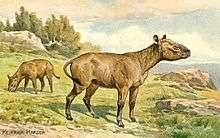Hyracodontidae
The Hyracodontidae are an extinct family of rhinoceroses endemic to North America, Europe, and Asia during the Eocene through early Miocene, living from 48.6–26.3 million years ago (Mya), existing about 22.3 million years.[2]
| Hyracodontidae | |
|---|---|
 | |
| Hyracodon | |
| Scientific classification | |
| Kingdom: | Animalia |
| Phylum: | Chordata |
| Class: | Mammalia |
| Order: | Perissodactyla |
| Superfamily: | Rhinocerotoidea |
| Family: | †Hyracodontidae Cope, 1879[1] |
| Subfamilies | |
| |
They are typified as having long limbs and no horns. These animals were initially modest in size and fast-moving, having evolved from smaller members of the Rhinocerotoidea during the Late Eocene and Early Oligocene. They later evolved into gigantic forms that included the largest terrestrial mammals ever to have lived (the Indricotheriinae or Paraceratheriinae).
The Hyracodontidae thrived in the rainforests of Kazakhstan, Pakistan, and southwest China, a former coastal region. Fossil evidence also extends their geographical range to Germany.
References
- McKenna, M. C; S. K. Bell (1997). Classification of Mammals Above the Species Level. Columbia University Press. ISBN 0-231-11012-X.
- "Fossilworks: Hyracodontidae". paleodb.org. Retrieved 2018-11-12.
Further reading
- Lucas, S. G. & Sobus, J. C., (1989), The Systematics of Indricotheres. 358–378 in Prothero, D. R. & Schoch, R. M., (eds.) 1989: The Evolution of Perissodactyls, Oxford University Press, New York, New York & Oxford, England.